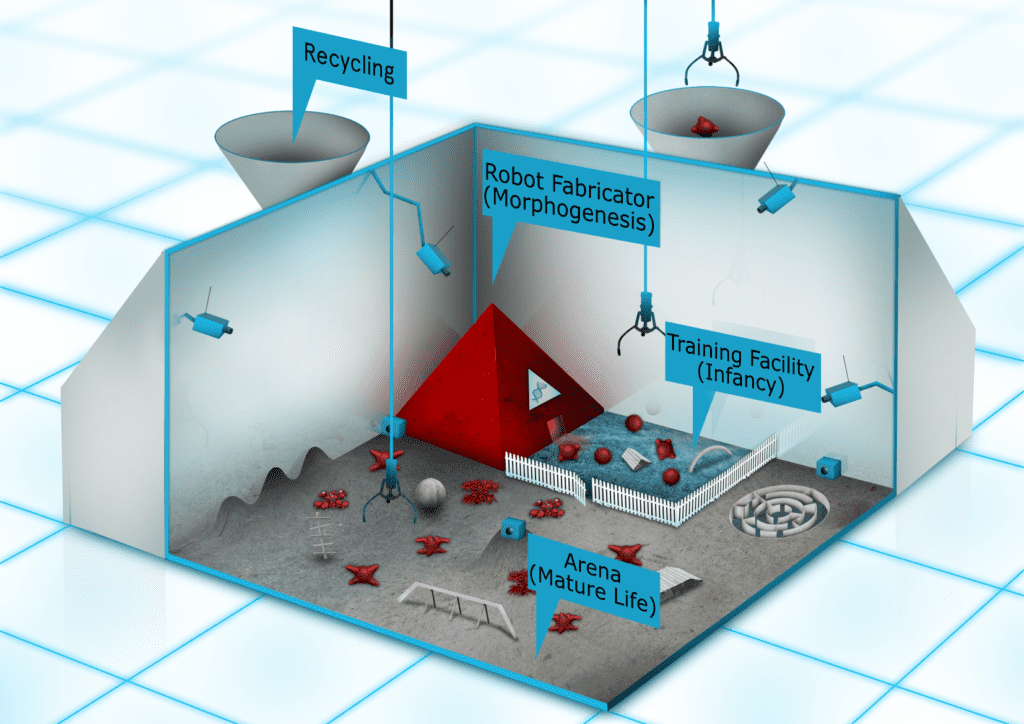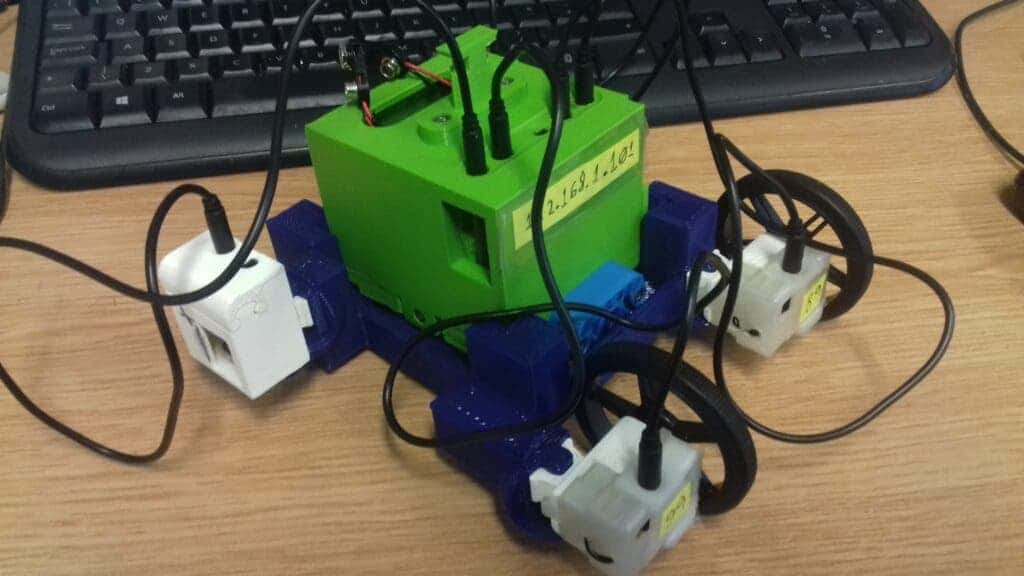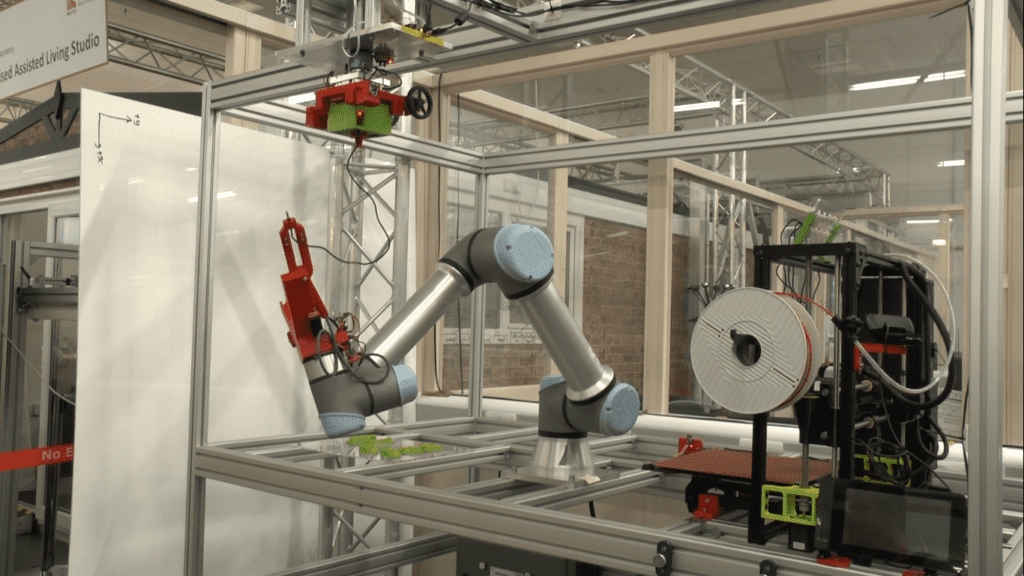Where biology and technology meet, evolutionary robotics is spawning automatons evolving in real-time and space. The basis of this field, evolutionary computing, sees robots possessing a virtual genome ‘mate’ to ‘reproduce’ improved offspring in response to complex, harsh environments.

Hard-bodied robots are now able to ‘give birth’
Robots have changed a lot over the past 30 years, already capable of replacing their human counterparts in some cases — in many ways, robots are already the backbone of commerce and industry. Performing a flurry of jobs and roles, they have been miniaturized, mounted, and molded into mammoth proportions to achieve feats way beyond human abilities. But what happens when unstable situations or environments call for robots never seen on earth before?
For instance, we may need robots to clean up a nuclear meltdown deemed unsafe for humans, explore an asteroid in orbit or terraform a distant planet. So how would we go about that?
Scientists could guess what the robot may need to do, running untold computer simulations based on realistic scenarios that the robot could be faced with. Then, armed with the results from the simulations, they can send the bots hurtling into uncharted darkness aboard a hundred-billion dollar machine, keeping their fingers crossed that their rigid designs will hold up for as long as needed.
But what if there was a is a better alternative? What if there was a type of artificial intelligence that could take lessons from evolution to generate robots that can adapt to their environment? It sounds like something from a sci-fi novel — but it’s exactly what a multi-institutional team in the UK is currently doing in a project called Autonomous Robot Evolution (ARE).
Remarkably, they’ve already created robots that can ‘mate’ and ‘reproduce’ progeny with no human input. What’s more, using the evolutionary theory of variation and selection, these robots can optimize their descendants depending on a set of activities over generations. If viable, this would be a way to produce robots that can autonomously adapt to unpredictable environments – their extended mechanical family changing along with their volatile surroundings.
“Robot evolution provides endless possibilities to tweak the system,” says evolutionary ecologist and ARE team member Jacintha Ellers. “We can come up with novel types of creatures and see how they perform under different selection pressures.” Offering a way to explore evolutionary principles to set up an almost infinite number of “what if” questions.
What is evolutionary computation?
In computer science, evolutionary computation is a set of laborious algorithms inspired by biological evolution where candidate solutions are generated and constantly “evolved”. Each new generation removes less desired solutions, introducing small adaptive changes or mutations to produce a cyber version of survival of the fittest. It’s a way to mimic biological evolution, resulting in the best version of the robot for its current role and environment.

Evolutionary robotics begins at ARE in a facility dubbed the EvoSphere, where newly assembled baby robots download an artificial genetic code that defines their bodies and brains. This is where two-parent robots come together to mingle virtual genomes to create improved young, incorporating both their genetic codes.
The newly evolved offspring is built autonomously via a 3D printer, after which a mechanical assembly arm translating the inherited virtual genomic code selects and attaches the specified sensors and means of locomotion from a bank of pre-built components. Finally, the artificial system wires up a Raspberry Pi computer acting as a brain to the sensors and motors – software is then downloaded from both parents to represent the evolved brain.
1. Artificial intelligence teaches newborn robots how to control their bodies
Newborns undergo brain development and learning to fine-tune their motor control in most animal species. This process is even more intense for these robotic infants due to breeding between different species. For example, a parent with wheels might procreate with another possessing a jointed leg, resulting in offspring with both types of locomotion.
But, the inherited brain may struggle to control the new body, so an algorithm is run as part of the learning stage to refine the brain over a few trials in a simplified environment. If the synthetic babies can master their new bodies, they can proceed to the next phase: testing.
2. Selection of the fittest- who can reproduce?
A specially built inert nuclear reactor housing is used by ARE for testing where young robots must identify and clear radioactive waste while avoiding various obstacles. After completing the task, the system scores each robot according to its performance which it then uses to determine who will be permitted to reproduce.

Software simulating reproduction then takes the virtual DNA of two parents and performs genetic recombination and mutation to generate a new robot, completing the ‘circuit of life.’ Parent robots can either remain in the population, have more children, or be recycled.
Evolutionary roboticist and ARE researcher Guszti Eiben says this sped up evolution works as: “Robotic experiments can be conducted under controllable conditions and validated over many repetitions, something that is hard to achieve when working with biological organisms.”
3. Real-world robots can also mate in alternative cyberworlds
In her article for the New Scientist, Emma Hart, ARE member and professor of computational intelligence at Edinburgh Napier University, writes that by “working with real robots rather than simulations, we eliminate any reality gap. However, printing and assembling each new machine takes about 4 hours, depending on the complexity of its skeleton, so limits the speed at which a population can evolve. To address this drawback, we also study evolution in a parallel, virtual world.”
This parallel universe entails the creation of a digital version of every mechanical infant in a simulator once mating has occurred, which enables the ARE researchers to build and test new designs within seconds, identifying those that look workable.
Their cyber genomes can then be prioritized for fabrication into real-world robots, allowing virtual and physical robots to breed with each other, adding to the real-life gene pool created by the mating of two material automatons.
The dangers of self-evolving robots – how can we stay safe?

Even though this program is brimming with potential, Professor Hart cautions that progress is slow, and furthermore, there are long-term risks to the approach.
“In principle, the potential opportunities are great, but we also run the risk that things might get out of control, creating robots with unintended behaviors that could cause damage or even harm humans,” Hart says.
“We need to think about this now, while the technology is still being developed. Limiting the availability of materials from which to fabricate new robots provides one safeguard.” Therefore: “We could also anticipate unwanted behaviors by continually monitoring the evolved robots, then using that information to build analytical models to predict future problems. The most obvious and effective solution is to use a centralized reproduction system with a human overseer equipped with a kill switch.”
A world made better by robots evolving alongside us
Despite these concerns, she counters that even though some applications, such as interstellar travel, may seem years off, the ARE system may have a more immediate need. And as climate change reaches dangerous proportions, it is clear that robot manufacturers need to become greener. She proposes that they could reduce their ecological footprint by using the system to build novel robots from sustainable materials that operate at low energy levels and are easily repaired and recycled.
Hart concludes that these divergent progeny probably won’t look anything like the robots we see around us today, but that is where artificial evolution can help. Unrestrained by human cognition, computerized evolution can generate creative solutions we cannot even conceive of yet.
And it would appear these machines will now evolve us even further as we step back and hand them the reins of their own virtual lives. How this will affect the human race remains to be seen.


